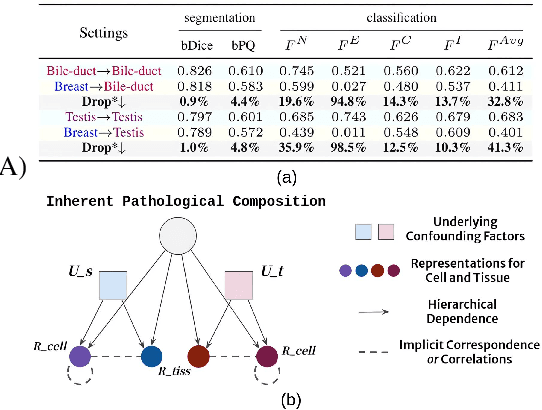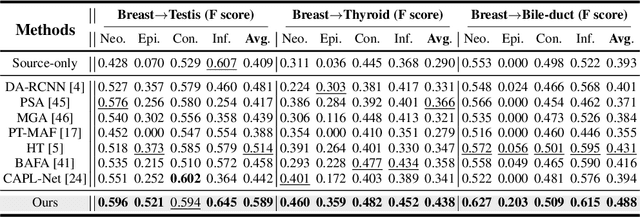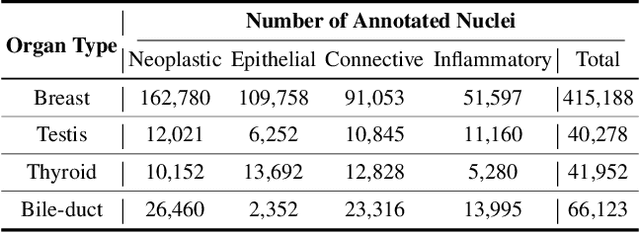Mei Chen
DeCafNet: Delegate and Conquer for Efficient Temporal Grounding in Long Videos
May 22, 2025Abstract:Long Video Temporal Grounding (LVTG) aims at identifying specific moments within lengthy videos based on user-provided text queries for effective content retrieval. The approach taken by existing methods of dividing video into clips and processing each clip via a full-scale expert encoder is challenging to scale due to prohibitive computational costs of processing a large number of clips in long videos. To address this issue, we introduce DeCafNet, an approach employing ``delegate-and-conquer'' strategy to achieve computation efficiency without sacrificing grounding performance. DeCafNet introduces a sidekick encoder that performs dense feature extraction over all video clips in a resource-efficient manner, while generating a saliency map to identify the most relevant clips for full processing by the expert encoder. To effectively leverage features from sidekick and expert encoders that exist at different temporal resolutions, we introduce DeCaf-Grounder, which unifies and refines them via query-aware temporal aggregation and multi-scale temporal refinement for accurate grounding. Experiments on two LTVG benchmark datasets demonstrate that DeCafNet reduces computation by up to 47\% while still outperforming existing methods, establishing a new state-of-the-art for LTVG in terms of both efficiency and performance. Our code is available at https://github.com/ZijiaLewisLu/CVPR2025-DeCafNet.
Defense against Prompt Injection Attacks via Mixture of Encodings
Apr 10, 2025Abstract:Large Language Models (LLMs) have emerged as a dominant approach for a wide range of NLP tasks, with their access to external information further enhancing their capabilities. However, this introduces new vulnerabilities, known as prompt injection attacks, where external content embeds malicious instructions that manipulate the LLM's output. Recently, the Base64 defense has been recognized as one of the most effective methods for reducing success rate of prompt injection attacks. Despite its efficacy, this method can degrade LLM performance on certain NLP tasks. To address this challenge, we propose a novel defense mechanism: mixture of encodings, which utilizes multiple character encodings, including Base64. Extensive experimental results show that our method achieves one of the lowest attack success rates under prompt injection attacks, while maintaining high performance across all NLP tasks, outperforming existing character encoding-based defense methods. This underscores the effectiveness of our mixture of encodings strategy for both safety and task performance metrics.
Step-Audio: Unified Understanding and Generation in Intelligent Speech Interaction
Feb 18, 2025Abstract:Real-time speech interaction, serving as a fundamental interface for human-machine collaboration, holds immense potential. However, current open-source models face limitations such as high costs in voice data collection, weakness in dynamic control, and limited intelligence. To address these challenges, this paper introduces Step-Audio, the first production-ready open-source solution. Key contributions include: 1) a 130B-parameter unified speech-text multi-modal model that achieves unified understanding and generation, with the Step-Audio-Chat version open-sourced; 2) a generative speech data engine that establishes an affordable voice cloning framework and produces the open-sourced lightweight Step-Audio-TTS-3B model through distillation; 3) an instruction-driven fine control system enabling dynamic adjustments across dialects, emotions, singing, and RAP; 4) an enhanced cognitive architecture augmented with tool calling and role-playing abilities to manage complex tasks effectively. Based on our new StepEval-Audio-360 evaluation benchmark, Step-Audio achieves state-of-the-art performance in human evaluations, especially in terms of instruction following. On open-source benchmarks like LLaMA Question, shows 9.3% average performance improvement, demonstrating our commitment to advancing the development of open-source multi-modal language technologies. Our code and models are available at https://github.com/stepfun-ai/Step-Audio.
Hummingbird: High Fidelity Image Generation via Multimodal Context Alignment
Feb 07, 2025



Abstract:While diffusion models are powerful in generating high-quality, diverse synthetic data for object-centric tasks, existing methods struggle with scene-aware tasks such as Visual Question Answering (VQA) and Human-Object Interaction (HOI) Reasoning, where it is critical to preserve scene attributes in generated images consistent with a multimodal context, i.e. a reference image with accompanying text guidance query. To address this, we introduce Hummingbird, the first diffusion-based image generator which, given a multimodal context, generates highly diverse images w.r.t. the reference image while ensuring high fidelity by accurately preserving scene attributes, such as object interactions and spatial relationships from the text guidance. Hummingbird employs a novel Multimodal Context Evaluator that simultaneously optimizes our formulated Global Semantic and Fine-grained Consistency Rewards to ensure generated images preserve the scene attributes of reference images in relation to the text guidance while maintaining diversity. As the first model to address the task of maintaining both diversity and fidelity given a multimodal context, we introduce a new benchmark formulation incorporating MME Perception and Bongard HOI datasets. Benchmark experiments show Hummingbird outperforms all existing methods by achieving superior fidelity while maintaining diversity, validating Hummingbird's potential as a robust multimodal context-aligned image generator in complex visual tasks.
PediaBench: A Comprehensive Chinese Pediatric Dataset for Benchmarking Large Language Models
Dec 09, 2024



Abstract:The emergence of Large Language Models (LLMs) in the medical domain has stressed a compelling need for standard datasets to evaluate their question-answering (QA) performance. Although there have been several benchmark datasets for medical QA, they either cover common knowledge across different departments or are specific to another department rather than pediatrics. Moreover, some of them are limited to objective questions and do not measure the generation capacity of LLMs. Therefore, they cannot comprehensively assess the QA ability of LLMs in pediatrics. To fill this gap, we construct PediaBench, the first Chinese pediatric dataset for LLM evaluation. Specifically, it contains 4,565 objective questions and 1,632 subjective questions spanning 12 pediatric disease groups. It adopts an integrated scoring criterion based on different difficulty levels to thoroughly assess the proficiency of an LLM in instruction following, knowledge understanding, clinical case analysis, etc. Finally, we validate the effectiveness of PediaBench with extensive experiments on 20 open-source and commercial LLMs. Through an in-depth analysis of experimental results, we offer insights into the ability of LLMs to answer pediatric questions in the Chinese context, highlighting their limitations for further improvements. Our code and data are published at https://github.com/ACMISLab/PediaBench.
SplatFlow: Self-Supervised Dynamic Gaussian Splatting in Neural Motion Flow Field for Autonomous Driving
Nov 23, 2024



Abstract:Most existing Dynamic Gaussian Splatting methods for complex dynamic urban scenarios rely on accurate object-level supervision from expensive manual labeling, limiting their scalability in real-world applications. In this paper, we introduce SplatFlow, a Self-Supervised Dynamic Gaussian Splatting within Neural Motion Flow Fields (NMFF) to learn 4D space-time representations without requiring tracked 3D bounding boxes, enabling accurate dynamic scene reconstruction and novel view RGB, depth and flow synthesis. SplatFlow designs a unified framework to seamlessly integrate time-dependent 4D Gaussian representation within NMFF, where NMFF is a set of implicit functions to model temporal motions of both LiDAR points and Gaussians as continuous motion flow fields. Leveraging NMFF, SplatFlow effectively decomposes static background and dynamic objects, representing them with 3D and 4D Gaussian primitives, respectively. NMFF also models the status correspondences of each 4D Gaussian across time, which aggregates temporal features to enhance cross-view consistency of dynamic components. SplatFlow further improves dynamic scene identification by distilling features from 2D foundational models into 4D space-time representation. Comprehensive evaluations conducted on the Waymo Open Dataset and KITTI Dataset validate SplatFlow's state-of-the-art (SOTA) performance for both image reconstruction and novel view synthesis in dynamic urban scenarios.
Cell as Point: One-Stage Framework for Efficient Cell Tracking
Nov 22, 2024



Abstract:Cellular activities are dynamic and intricate, playing a crucial role in advancing diagnostic and therapeutic techniques, yet they often require substantial resources for accurate tracking. Despite recent progress, the conventional multi-stage cell tracking approaches not only heavily rely on detection or segmentation results as a prerequisite for the tracking stage, demanding plenty of refined segmentation masks, but are also deteriorated by imbalanced and long sequence data, leading to under-learning in training and missing cells in inference procedures. To alleviate the above issues, this paper proposes the novel end-to-end CAP framework, which leverages the idea of regarding Cell as Point to achieve efficient and stable cell tracking in one stage. CAP abandons detection or segmentation stages and simplifies the process by exploiting the correlation among the trajectories of cell points to track cells jointly, thus reducing the label demand and complexity of the pipeline. With cell point trajectory and visibility to represent cell locations and lineage relationships, CAP leverages the key innovations of adaptive event-guided (AEG) sampling for addressing data imbalance in cell division events and the rolling-as-window (RAW) inference method to ensure continuous tracking of new cells in the long term. Eliminating the need for a prerequisite detection or segmentation stage, CAP demonstrates strong cell tracking performance while also being 10 to 55 times more efficient than existing methods. The code and models will be released.
Phenome-wide causal proteomics enhance systemic lupus erythematosus flare prediction: A study in Asian populations
Nov 18, 2024Abstract:Objective: Systemic lupus erythematosus (SLE) is a complex autoimmune disease characterized by unpredictable flares. This study aimed to develop a novel proteomics-based risk prediction model specifically for Asian SLE populations to enhance personalized disease management and early intervention. Methods: A longitudinal cohort study was conducted over 48 weeks, including 139 SLE patients monitored every 12 weeks. Patients were classified into flare (n = 53) and non-flare (n = 86) groups. Baseline plasma samples underwent data-independent acquisition (DIA) proteomics analysis, and phenome-wide Mendelian randomization (PheWAS) was performed to evaluate causal relationships between proteins and clinical predictors. Logistic regression (LR) and random forest (RF) models were used to integrate proteomic and clinical data for flare risk prediction. Results: Five proteins (SAA1, B4GALT5, GIT2, NAA15, and RPIA) were significantly associated with SLE Disease Activity Index-2K (SLEDAI-2K) scores and 1-year flare risk, implicating key pathways such as B-cell receptor signaling and platelet degranulation. SAA1 demonstrated causal effects on flare-related clinical markers, including hemoglobin and red blood cell counts. A combined model integrating clinical and proteomic data achieved the highest predictive accuracy (AUC = 0.769), surpassing individual models. SAA1 was highlighted as a priority biomarker for rapid flare discrimination. Conclusion: The integration of proteomic and clinical data significantly improves flare prediction in Asian SLE patients. The identification of key proteins and their causal relationships with flare-related clinical markers provides valuable insights for proactive SLE management and personalized therapeutic approaches.
Revisiting Adaptive Cellular Recognition Under Domain Shifts: A Contextual Correspondence View
Jul 19, 2024



Abstract:Cellular nuclei recognition serves as a fundamental and essential step in the workflow of digital pathology. However, with disparate source organs and staining procedures among histology image clusters, the scanned tiles inherently conform to a non-uniform data distribution, which induces deteriorated promises for general cross-cohort usages. Despite the latest efforts leveraging domain adaptation to mitigate distributional discrepancy, those methods are subjected to modeling the morphological characteristics of each cell individually, disregarding the hierarchical latent structure and intrinsic contextual correspondences across the tumor micro-environment. In this work, we identify the importance of implicit correspondences across biological contexts for exploiting domain-invariant pathological composition and thereby propose to exploit the dependence over various biological structures for domain adaptive cellular recognition. We discover those high-level correspondences via unsupervised contextual modeling and use them as bridges to facilitate adaptation over diverse organs and stains. In addition, to further exploit the rich spatial contexts embedded amongst nuclear communities, we propose self-adaptive dynamic distillation to secure instance-aware trade-offs across different model constituents. The proposed method is extensively evaluated on a broad spectrum of cross-domain settings under miscellaneous data distribution shifts and outperforms the state-of-the-art methods by a substantial margin. Code is available at https://github.com/camwew/CellularRecognition_DA_CC.
LoSA: Long-Short-range Adapter for Scaling End-to-End Temporal Action Localization
Apr 01, 2024



Abstract:Temporal Action Localization (TAL) involves localizing and classifying action snippets in an untrimmed video. The emergence of large video foundation models has led RGB-only video backbones to outperform previous methods needing both RGB and optical flow modalities. Leveraging these large models is often limited to training only the TAL head due to the prohibitively large GPU memory required to adapt the video backbone for TAL. To overcome this limitation, we introduce LoSA, the first memory-and-parameter-efficient backbone adapter designed specifically for TAL to handle untrimmed videos. LoSA specializes for TAL by introducing Long-Short-range Adapters that adapt the intermediate layers of the video backbone over different temporal ranges. These adapters run parallel to the video backbone to significantly reduce memory footprint. LoSA also includes Long-Short-range Fusion that strategically combines the output of these adapters from the video backbone layers to enhance the video features provided to the TAL head. Experiments show that LoSA significantly outperforms all existing methods on standard TAL benchmarks, THUMOS-14 and ActivityNet-v1.3, by scaling end-to-end backbone adaptation to billion-parameter-plus models like VideoMAEv2~(ViT-g) and leveraging them beyond head-only transfer learning.
 Add to Chrome
Add to Chrome Add to Firefox
Add to Firefox Add to Edge
Add to Edge